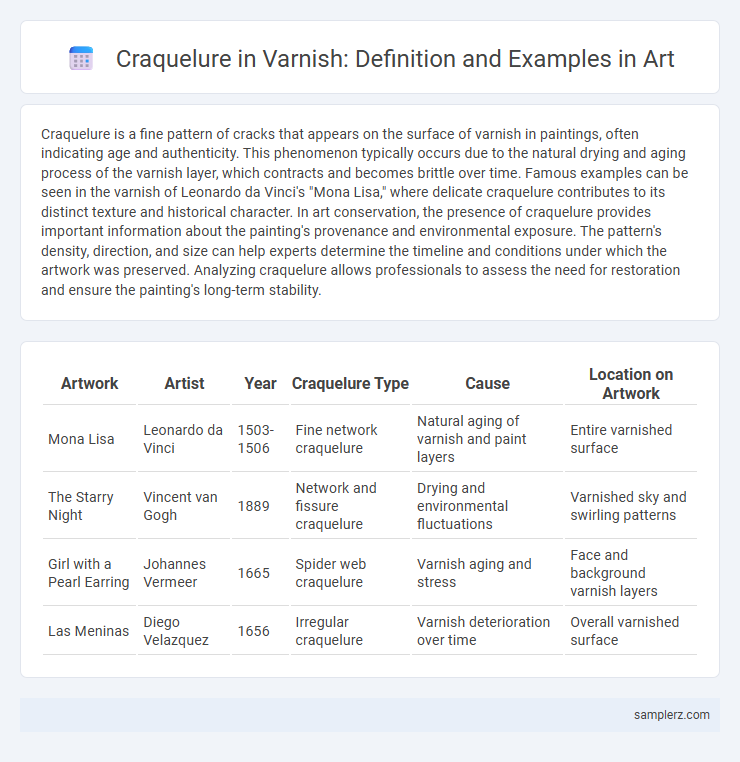Craquelure is a fine pattern of cracks that appears on the surface of varnish in paintings, often indicating age and authenticity. This phenomenon typically occurs due to the natural drying and aging process of the varnish layer, which contracts and becomes brittle over time. Famous examples can be seen in the varnish of Leonardo da Vinci's "Mona Lisa," where delicate craquelure contributes to its distinct texture and historical character. In art conservation, the presence of craquelure provides important information about the painting's provenance and environmental exposure. The pattern's density, direction, and size can help experts determine the timeline and conditions under which the artwork was preserved. Analyzing craquelure allows professionals to assess the need for restoration and ensure the painting's long-term stability.
Table of Comparison
| Artwork | Artist | Year | Craquelure Type | Cause | Location on Artwork |
|---|---|---|---|---|---|
| Mona Lisa | Leonardo da Vinci | 1503-1506 | Fine network craquelure | Natural aging of varnish and paint layers | Entire varnished surface |
| The Starry Night | Vincent van Gogh | 1889 | Network and fissure craquelure | Drying and environmental fluctuations | Varnished sky and swirling patterns |
| Girl with a Pearl Earring | Johannes Vermeer | 1665 | Spider web craquelure | Varnish aging and stress | Face and background varnish layers |
| Las Meninas | Diego Velazquez | 1656 | Irregular craquelure | Varnish deterioration over time | Overall varnished surface |
Understanding Craquelure: Definition and Origins
Craquelure refers to the fine network of cracks that develops on the surface of paintings, particularly in varnish layers, as a result of aging and environmental factors. This phenomenon occurs due to the natural drying and shrinking of materials like oil paint and varnish over time, influenced by fluctuations in temperature and humidity. Understanding craquelure aids art conservators in authenticating artworks and assessing their condition, revealing valuable clues about an artwork's age and preservation history.
Common Causes of Craquelure in Art Varnish
Craquelure in art varnish commonly results from natural aging processes where fluctuations in temperature and humidity cause the varnish layer to expand and contract unevenly. Incompatible materials between the varnish and underlying paint layer create tension, leading to fine network cracks over time. Mechanical stress from environmental vibrations or misapplication during restoration also contributes significantly to the formation of craquelure patterns.
Historical Paintings Exhibiting Varnish Craquelure
Historical paintings exhibiting varnish craquelure, such as Leonardo da Vinci's "Mona Lisa" and Rembrandt's works, reveal fine networks of cracks caused by the natural aging of varnish layers. This phenomenon often occurs due to the differential drying rates between the varnish and underlying paint, compounded by environmental factors like humidity and temperature fluctuations. Conservators study these craquelure patterns to authenticate artworks and understand their preservation history.
Craquelure Patterns: Types and Variations in Varnish
Craquelure in varnish manifests through distinct patterns such as fine network, spiderweb, and checkerboard cracks, each revealing the aging process and environmental stress on paintings. Variations in craquelure depend on factors like varnish composition, application technique, and drying conditions, influencing the texture and visual depth of the artwork. These patterns serve as critical diagnostic tools in art conservation and authentication, reflecting the interaction between materials and time.
Famous Artworks with Notable Varnish Craquelure
Famous artworks such as Leonardo da Vinci's "Mona Lisa" and Johannes Vermeer's "Girl with a Pearl Earring" exhibit notable varnish craquelure patterns, revealing the artworks' age and environmental exposure. The fine network of cracks in aged varnish serves as a fingerprint of conservation history and material composition. These craquelure patterns are critical for art restorers to assess preservation techniques and authenticate masterpieces.
Techniques for Identifying Craquelure in Varnish Layers
Microscopic analysis reveals distinctive cracking patterns in varnish layers, aiding in the identification of craquelure by highlighting the network of fine fissures characteristic of aged surfaces. Infrared reflectography penetrates varnish to expose sublayers, differentiating natural craquelure from restoration cracks through their depth and distribution. Ultraviolet fluorescence further distinguishes varnish deterioration by causing old varnish craquelure to fluoresce differently compared to newer retouching areas.
Conservation Challenges of Varnished Craquelure
Craquelure in varnish presents significant conservation challenges, as the fine network of cracks can trap dirt and pollutants, accelerating the deterioration of underlying paint layers. Restorers must carefully balance the removal of contaminants without exacerbating the fragile fissures, often requiring advanced microscopy and solvent testing to ensure compatibility. Successful preservation of varnished craquelure demands meticulous environmental control and periodic monitoring to prevent further mechanical stress and moisture fluctuations.
Scientific Analysis Methods for Varnish Craquelure
Scientific analysis methods for varnish craquelure include infrared spectroscopy, which identifies chemical changes in the varnish layer, and scanning electron microscopy (SEM) that reveals the microstructure of the cracks. X-ray fluorescence (XRF) provides elemental composition data to differentiate original varnish from restoration materials. These techniques enable precise characterization of the varnish's aging process, crucial for conservation strategies.
Craquelure’s Role in Authenticating Artworks
Craquelure patterns in varnish serve as crucial forensic indicators for authenticating paintings by revealing aging and environmental impacts unique to each artwork. Scientific analysis of these fine cracks, including their formation, depth, and network, helps differentiate genuine pieces from forgeries. In art conservation, understanding craquelure enables experts to trace the historical timeline and verify the provenance of masterpieces.
Case Studies: Restoration of Craquelured Varnish
Craquelure in varnish often appears in Old Master paintings, such as Rembrandt's "The Night Watch," where fine cracks result from aging and environmental stress. Restoration experts utilize controlled cleaning and consolidation techniques to stabilize the varnish, preventing further deterioration while preserving the artwork's original texture. Advanced imaging methods like infrared reflectography aid in mapping the crack patterns, guiding precise interventions during the conservation process.

example of craquelure in varnish Infographic
 samplerz.com
samplerz.com